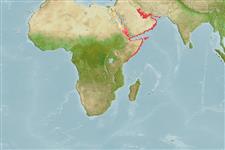Environment: milieu / climate zone / depth range / distribution range
Ecologia
marino demersale; distribuzione batimetrica 20 - 50 m (Ref. 28016). Tropical; 30°N - 2°S, 32°E - 62°E
Western Indian Ocean: Persian Gulf (Ref. 3467) to the Red Sea and immigrated via the Suez Canal to the Mediterranean Sea (Ref. 11441).
Size / Peso / Age
Maturity: Lm ? range ? - ? cm
Max length : 25.0 cm TL maschio/sesso non determinato; (Ref. 30573)
Short description
Chiavi di identificazione | Morfologia | Morfometria
Spine dorsali (totale) : 1; Raggi dorsali molli (totale) : 30 - 33; Raggi anali molli: 30 - 33.
Lives in coastal rocky substrate, usually with vegetation. Consumes small invertebrates plucked from rocks (Ref. 52629). One of the earlier Lessepsian immigrants actually well
established in the eastern part of the Mediterranean Sea and it inhabits various substrates and is usually encountered on rocky bottoms with vegetation, sandy and muddy bottoms as well as seagrass meadows (Ref. 104758).
Life cycle and mating behavior
Maturities | Riproduzione | Spawnings | Egg(s) | Fecundities | Larve
Hutchins, J.B., 1984. Monacanthidae. In W. Fischer and G. Bianchi (eds.) FAO species identification sheets for fishery purposes. Western Indian Ocean (Fishing Area 51). Vol. 3. FAO, Rome. pag. var. (Ref. 3467)
IUCN Red List Status (Ref. 130435)
Threat to humans
Harmless
Human uses
Pesca: scarso interesse commerciale
Strumenti
Special reports
Download XML
Fonti Internet
Estimates based on models
Preferred temperature (Ref.
123201): 23.5 - 29.2, mean 26.1 °C (based on 42 cells).
Phylogenetic diversity index (Ref.
82804): PD
50 = 0.5312 [Uniqueness, from 0.5 = low to 2.0 = high].
Bayesian length-weight: a=0.01738 (0.01425 - 0.02120), b=2.92 (2.86 - 2.98), in cm total length, based on LWR estimates for this species (Ref.
93245).
Trophic level (Ref.
69278): 4.6 ±0.09 se; based on food items.
Resilienza (Ref.
120179): Medio, tempo minimo di raddoppiamento della popolazione 1.4 - 4.4 anni (Preliminary K or Fecundity.).
Fishing Vulnerability (Ref.
59153): Low vulnerability (15 of 100).
Nutrients (Ref.
124155): Calcium = 161 [58, 382] mg/100g; Iron = 1.35 [0.56, 3.19] mg/100g; Protein = 17.1 [14.9, 19.4] %; Omega3 = 0.164 [0.063, 0.399] g/100g; Selenium = 54.6 [24.2, 127.5] μg/100g; VitaminA = 14.8 [4.3, 51.1] μg/100g; Zinc = 1.38 [0.89, 2.24] mg/100g (wet weight);
